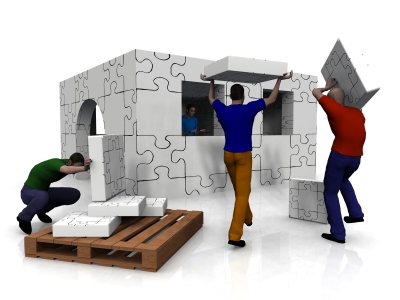 Constructing an RCIA process is similar to building a house. An architect does not worry about the color of paint in the living room. She focuses instead on how many rooms to build and where the walls will go. After the walls are up and the roof is on, then we can focus on some of the finer details.
Constructing an RCIA process is similar to building a house. An architect does not worry about the color of paint in the living room. She focuses instead on how many rooms to build and where the walls will go. After the walls are up and the roof is on, then we can focus on some of the finer details.
So what are the rooms of the RCIA process? There are six rooms every initiation process must have.
Gradual entryway
First we have to erect the walls for a welcoming entryway. We do this by making initiation “a gradual process” (RCIA 4). There is no set schedule, especially at the beginning. Designing a calendar of topics before we even have catechumens weakens the walls of this room.
Community room
As seekers enter into the initiation process, they are entering into “the community of the faithful” (RCIA 4). Whatever your parish is doing right now is your teaching process. Sequestering the catechumens into weekly small group meetings, especially at the beginning, delays the construction of this room.
Story room
The heart of every initiation process is “reflecting on the value of the paschal mystery” (RCIA 4). We can get caught up in a lot of theological language about what we mean by “paschal mystery.” A clear, simple way to describe the paschal mystery to seekers is to say these are our stories of love, sacrifice, and forgiveness.
Most of what we do in the initiation process should be telling these stories from our own lives, from the lives of the saints, from the stories in the Bible (especially the gospels), and from the tradition of the church.
Changing room
Every time we truly focus on the paschal mystery, we are changed. The RCIA says that “by renewing their own conversion, the faithful provide an example that will help the catechumens” (RCIA 4). If we first of all worry about getting all the doctrine covered without first showing how we have been changed by the Holy Spirit, we will never get this room built.
Formal living room
When I was a kid, my neighbors had a living room that I was not allowed into. Only the adults could go in there, except on very rare occasions like Christmas or Easter. And then the children had to be on their best behavior. Initiation “is suited to a spiritual journey of adults” (RCIA 5). We confront adult challenges and make adult decisions. Children who are spiritually mature enough can learn to meet these challenges and make these decisions, but it’s not kid stuff. If we create a completely separate children’s process that does not take the sacrifices of discipleship seriously, this room will be empty most of the time.
Man cave, sewing room, rec room
The initiation process “varies according to the many forms of God’s grace” (RCIA 5). The rooms of the journey and the path through them will not be identical for each seeker. If we try to build the exact same house for every seeker, we will seriously damage the integrity of the structure. As RCIA teams, we have to attend to the unique call of the Holy Spirit for every person, and we have to find a way to honor that call in our initiation processes.
Curtains and paint
The details are not unimportant. My wife and I spent an unbelievable amount of time picking out floor tile for our kitchen. But we had to have the kitchen first. RCIA leaders have to first make sure there is a solid construction in place and only then start focusing on all of the finer details of the initiation process.
What does your structure look like?
Please take a moment to describe how you built your initiation process. How do you make sure each of the core rooms are included in your RCIA process?









Thank you Diana and Nick
“Most of what we do in the initiation process should be telling these stories from our own lives, from the lives of the saints, from the stories in the Bible (especially the gospels), and from the tradition of the church.”
Storytelling has become an important component of the Period of Evangelization especially, though in the other periods as well. We speak of Jesus, their favorite parables, and I witness how the story of the Storm at Sea was my life. I make a point of sharing with them a “Saint of the Week” and tell how that saint lived a life that might connect with ours.
What are stories from the tradition of the church?